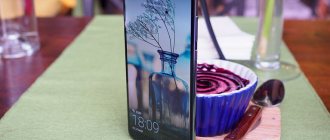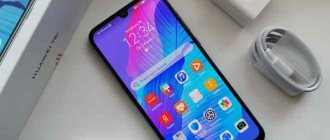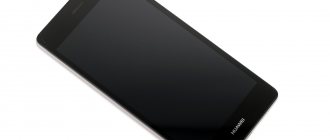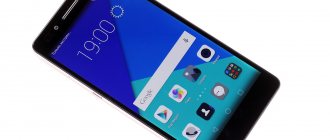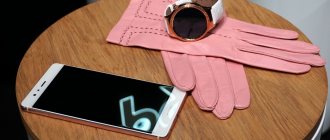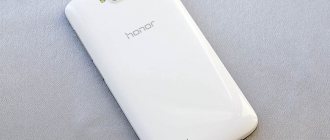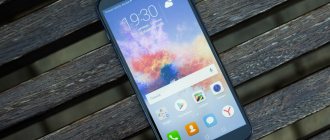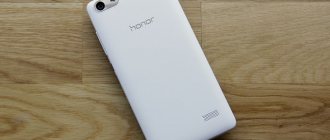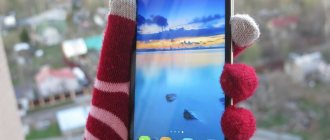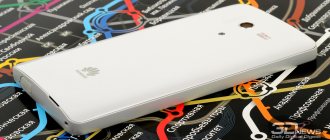The line between smartphones and tablets continues to blur, becoming thin, almost invisible. Numerous and quite popular “plafonds” (smart phones, phablets - choose from these stupid words the one that you personally like) like the Samsung GALAXY Note - something in between smartphones and tablets - are to blame for this. And in general, the dimensions of mobile phones have grown significantly over the past couple of years. Determining what exactly is in front of you – a large smartphone or a small tablet – is not always easy these days.
Historically, gadgets with a display diagonal of seven inches or more are considered to be tablets, and those with a smaller display diagonal are considered smartphones. The MediaPad X2 has a screen of exactly seven inches. That is, by nomenclature (and by name) it is a tablet. However, the gadget turned out to be so compact that, if necessary and with due diligence, it can fit in some wide pocket of a jacket or jacket. In addition, you can make calls from it in GSM networks, and it has two slots for SIM cards at its disposal. So Huawei MediaPad X2 is another bright representative of the “smart tablet” subclass.
⇡#Technical characteristics
| Huawei MediaPad X1 | Huawei MediaPad X2 | |
| Display | 7 inches, 1920 × 1200, matrix type – IPS + LTPS | 7 inches, 1920 × 1200, matrix type – IPS + LTPS |
| Touch screen | Capacitive (10 points), responds to touches with loose gloves | Capacitive (10 points), responds to touches with loose gloves |
| Air gap | No | No |
| Oleophobic coating | Eat | Eat |
| Polarizing filter | Eat | Eat |
| CPU | HiSilicon Kirin 910 (Hi6620): four cores ARM Cortex-A9 (ARMv7), frequency 1.6 GHz; 32-bit computing 28 nm HPm process technology | HiSilicon Kirin 930: four cores ARM Cortex-A53 (ARMv8), frequency 1.5 GHz + four cores ARM Cortex-A53e (ARMv8), frequency 2 GHz; 32-bit and 64-bit computing, ARM big.LITTLE (4+4) technology, 28 nm HPC process technology |
| Graphics controller | ARM Mali-450 MP4, 533 MHz | ARM Mali-T624 MP4, 600 MHz |
| RAM | 2 GB LPDDR3 | 2 GB LPDDR3 |
| Flash memory | 16 GB + microSD | 16 GB + microSD |
| Connectors | 1 × micro-USB 2.0 1 × 3.5 mm headset jack 1 × microSD 1 × micro-SIM | 1 × micro-USB 2.0 1 × 3.5 mm headset jack 1 × micro-SIM 1 × universal slot for nano-SIM or microSD |
| cellular | Built-in 2G/3G modem; optional 4G support Ability to make calls 2G: GSM/GPRS/EDGE 850/900/1800/1900 MHz 3G: DC-HSPA+ (42 Mbit/s) 4G: LTE Cat. 4 (150 Mbit/s) – optional One SIM card in micro-SIM format | Support for second, third and fourth generation networks; ability to make calls 2G: GSM/GPRS/EDGE 850/900/1800/1900 MHz 3G: DC-HSPA+ (42 Mbit/s) 850/900/1900/2100 MHz 4G: LTE Cat. 6 (300 Mbit/s) band 1/3/7/8/28/38/39/40/41 (2100/1800/2600/900/700/1900/2300/2500 MHz) One micro-format SIM card SIM + one nano-SIM SIM card; work in turns |
| WiFi | 802.11b/g/n, 2.4/5 GHz | 802.11a/b/g/n, 2.4/5 GHz |
| Bluetooth | 4.0 | 4.0 |
| NFC | No | No |
| IR port | No | No |
| Navigation | GPS, A-GPS, GLONASS | GPS, A-GPS, GLONASS |
| Sensors | Light sensor, proximity sensor, accelerometer/gyroscope, digital compass (magnetometer) | Light sensor, proximity sensor, accelerometer/gyroscope, digital compass (magnetometer), pedometer |
| Main camera | 13 MP (4160×3120), autofocus, LED flash | 13 MP (4160×3120), autofocus, LED flash |
| Front-camera | 5 MP (2592×1952), without autofocus | 5 MP (2592×1952), without autofocus |
| Nutrition | Non-removable battery Capacity 19 Wh (5000 mAh, 3.8 V) | Non-removable battery Capacity 19 Wh (5000 mAh, 3.8 V) |
| Size | 184 × 104 mm Case thickness 7.2 mm | 184 × 104 mm Case thickness 7.2 mm |
| Weight | 239 g | 239 g |
| operating system | Google Android 4.2.2 (Jelly Bean) Emotion UI 2.0 proprietary shell | Google Android 5.0.2 (Lollipop) Corporate shell Emotion UI 3.0 |
| Approximate price | 18,990 rubles for the version with a 3G modem 20,990 rubles for the version with a 4G modem | 24,990 rubles |
| Huawei MediaPad X2 – information about the system and hardware according to the CPU-Z application | ||||
Operating system and programs
The Huawei MediaPad X2 tablet runs on Android 5.0 OS with Emotion UI 3.0.5 shell. If you have always used regular Android, then you will have to get used to controlling this tablet. Instead of an application menu, program icons are placed on desktops, where they can be sorted into folders. Several interesting features have also been added to the shell, for example, several energy saving modes, a garbage cleaning utility, an accelerator and a call filter. If you've read at least one review of Huawei tablets on our website, you've probably noticed that Emotion UI is used on every device from this company.
⇡#Appearance and ergonomics
The exterior of the MediaPad X2 is exactly the same as its predecessor, the MediaPad X1. The dimensions of the tablet cases and their weight are the same up to tenths of a millimeter and a gram, respectively. There are no significant changes in the appearance of the device. The main feature of the MediaPad X1/X2 exterior is the very thin frames around the screen. At the top and bottom they do not exceed two centimeters, and at the sides the count goes on in millimeters. The display occupies about 80% of the front panel area, which is very good.
Meet Huawei MediaPad X2
The tablet body is still made of metal. The device is well assembled - there are enough stiffening ribs in the structure. The gadget does not creak or bend when the sides are squeezed, and characteristic colored streaks do not appear on the matrix.
Huawei MediaPad X2 – front panel
Like the X1, the X2 does not have any hardware keys on the front panel; all buttons are exclusively on-screen. At the top of the front panel there is a front-facing five-megapixel camera lens, a speaker mesh (by the way, another smartphone attribute) and a light sensor eye.
Huawei MediaPad X2 – right side
Perhaps the only noticeable difference in appearance between the X2 and X1 is that the new version has an additional universal connector next to the power and volume keys. It can be used for a microSD memory card or for a second SIM card of the nano-SIM standard. The predecessor could only work with one SIM card.
Huawei MediaPad X2 – sides
The body of the device is not too plump, its thickness is 7.2 millimeters. Narrow frames and low thickness make it easy to hold with one hand. Moreover, with proper dexterity, you can press the screen with the thumb of the same hand. The device weighs only 239 grams - it does not weigh down a backpack or bag much, and your hands do not get tired. Overall, the tablet is well suited for travel or other outdoor use cases.
| Huawei MediaPad X2 – interface layout | ||
From the point of view of ergonomics, the gadget turned out to be successful. All the connectors are in their places, you don’t have to look for them, you get used to the tablet quickly. The micro-USB interface is located on the bottom end, and the 3.5 mm audio jack for connecting a wired headset is on the top. The device is equipped with two microphones, with which an active noise reduction system is implemented.
Huawei MediaPad X2 – rear panel
The surface of the back panel of the device is rough, so it does not try to slip out of your hands during operation. The case, as usual, is non-separable. On the back panel there is a main 13-megapixel camera lens and an external speaker slot.
Huawei MediaPad X2 – external speaker
⇡#Display
As we said, the tablet has a seven-inch screen. Its resolution has not changed since the X1 - it is still 1920 × 1200 pixels (WUXGA, aspect ratio - 16:10, which is quite rare). This resolution can be considered optimal for this diagonal: the pixel density is very decent - more than 323 dots per inch, making it a pleasure to read electronic documents and books on the tablet. Fonts, even the smallest ones, look sharp. Movies and photographs are well detailed. There is a chance to see individual points only if you bring the device close to your eyes. Although even so they will not be noticeable at all - the “pixelization” effect is practically absent.
The screen is made using LTPS (Low Temperature Polysilicon) technology. This is a type of LCD screen made using low-temperature polysilicon, which makes it possible to expand the usable area of thin-film transistors (compared to screens based on amorphous polysilicon). LTPS technology has several advantages, the main ones being reduced power consumption and higher responsiveness. LTPS displays are used quite rarely in mobile devices due to their high cost, although recently they are becoming more common.
Working with the MediaPad X2 display is quite comfortable. Its contrast does not drop, even if you look away from the perpendicular, it is convenient to watch the movie, including together. The gadget quickly responds to touches and supports up to ten simultaneous presses.
Huawei MediaPad X2 – AnTuTu MultiTouch Test results
The screen's brightness reserve is quite large. The maximum luminosity of the white field is 442 cd/m2. This value is sufficient for comfortable operation of the device, including under direct sunlight. A very effective polarizing filter helps combat glare. By the way, there is no air gap between the protective glass of the front panel and the matrix, which also minimizes the number of unwanted reflections. Finally, the protective glass here has a grease-repellent layer, so the display is easy to clean from fingerprints and other small dirt.
The minimum luminosity of the white field is slightly less than 15 cd/m2, that is, the backlight boundaries are quite wide. Thanks to this, the device is convenient to use both in bright external lighting and in pitch darkness - it does not hurt your eyes. The tablet is equipped with a light sensor, thanks to which it can independently set the brightness level that is comfortable for working in certain conditions. Brightness adjustment occurs quite correctly and smoothly, without annoying jerks.
The luminosity of the black field is moderate by the standards of LCD screens - 0.43 cd/m2. At maximum brightness, the black color loses a little depth, but overall remains quite saturated. The tablet display has a decent contrast ratio of 1028:1.
Huawei MediaPad X2 – Grayscale Color Temperature
But the white balance is not set ideally - on average, the color temperature of shades of gray on the MediaPad X2 screen is 7400 K, which is slightly higher than the reference value of 6500 K. Because of this, the image on the display looks a little “colder” than it should, but not at all critical. However, for perfectionists, there is an option for software adjustment of color temperature - the user can adjust it to his preferences.
| Huawei MediaPad X2 – screen settings | ||
The display is well calibrated. All gamma curves – both color components and gray – coincide with the reference curve. This means that all colors on the MediaPad X2's display look exactly as vibrant as they should, with no bleeds or bleeds.
| Huawei MediaPad X2 – gamma curves | ||
The color gamut of the MediaPad X2 display is significantly wider than the reference sRGB color space. This is both good and bad at the same time. On the one hand, the colors on the screen look very saturated - some may like this. On the other hand, these colors do not at all correspond to what the creator of the image intended them to be. Unfortunately, the user cannot adjust the color rendering - changing color profiles is not provided in the tablet. Apart from the excessive color gamut, the MediaPad X2's display is very good.
Huawei MediaPad X2 – tablet screen color gamut (white triangle) compared to the sRGB reference space (black triangle)
Display
The Honor Play has a 6.3-inch screen, which occupies more than 83% of the total front panel area. The resolution of this IPS matrix is 2340 by 1080 pixels. It is worth noting the extremely unusual aspect ratio of 19.5:9. Thanks to this, it is very comfortable to control characters in games. This format and the device in general are great for various entertainment (cinema, Internet, photography, etc.).
The color scheme can be freely changed through the appropriate settings. The picture quality is very high. You will be pleased not only with excellent image detail, but also with fast response, as well as really rich shades. Viewing angles are close to maximum values.
More about Huawei: Reviews of Huawei smartphones – customer and owner ratings | Technopark
⇡#Hardware and performance
The new MediaPad X2 is built on the fresh Huawei HiSilicon Kirin 930 platform. Judging by the characteristics, it is much more powerful than the Kirin 910 chip that was used in the X1. The “930th” Kirin is based on the now popular ARM big.LITTLE architecture. One group of cores is designed to save energy when performing non-resource-intensive tasks - it includes four ARM Cortex-A53 cores operating at 1.5 GHz. The second group is designed for “heavy” applications and games - it is represented by four Cortex-A53 e , which operate at a higher frequency - 2 GHz.
But the technological process by which the Kirin 930 is made is no longer young – 28 nm. Many manufacturers of mobile systems-on-chip have already switched to more energy-efficient technical processes - 20 or even 14 nm.
The X2 has the same amount of memory as the X1: two gigabytes of RAM and sixteen gigabytes of built-in flash memory. True, for some countries the MediaPad X2 will be equipped with three gigabytes of RAM and thirty-two gigabytes of flash memory, but this version will not be officially supplied to Russia. However, two gigabytes of RAM is enough for comfortable work with the device: the gadget allows you to leave a large number of applications open, switching between numerous browser tabs occurs without forcing pages to refresh. So there is no particular need to chase the version with three gigabytes. As for flash memory, it can be expanded using microSD memory cards.
In the general synthetic test AnTuTu Benchmark 5, the Huawei MediaPad X2 tablet scored almost 49 thousand “parrots”. The result, it should be noted, is very decent! A couple of years ago, HiSilicon platforms could not even come close in power to Qualcomm and Samsung chips, but now they are playing in the same league with them - progress is obvious.
In terms of computing power, the Kirin 930 is a good platform. The tablet effortlessly copes with everyday tasks such as viewing multimedia content and web surfing, smoothly displays operating system animations, and quickly switches between open applications. The exception is games: the MediaPad X2 doesn't handle them very well. For example, even in a simple game task Basemark 2 Taiji, the gadget showed an average of 53.6 frames per second - that is, it could not reach the vSync limit (60 FPS).
And this is, frankly, quite strange. The graphics controller here is quite fresh and seems to be quite powerful - ARM Mali-T624 MP4, operating at 600 MHz. However, 3D games on the MediaPad X2 mostly slow down, the picture jerks - it’s not very convenient to play. There are no problems with casual 2D and 2.5D arcade games - they run quite smoothly. In general, the Huawei MediaPad X2 is unlikely to be suitable for gamers. This tablet is quite capable of handling all other tasks.
Performance
The Huawei MediaPad X2 tablet is equipped with a 64-bit 8-core HiSilicon Kirin 930 processor, which is a direct competitor to the top Qualcomm Snapdragon 810. It is manufactured using single-chip technology and has two clusters of 4 cores each: in one the maximum frequency is 2 GHz, and in the other - 1.5. They are switched on alternately, depending on the required load and the tasks being performed. The numbers are quite outstanding, but, nevertheless, the processor does not reach the flagship indicators. Performance tests show above-average results and, in principle, the tablet can compete with top-end devices.
The device operates very smoothly and quickly. This is additionally facilitated by 2 or 3 gigabytes of RAM, depending on the configuration. You will never feel short on power when performing normal daily tasks. The Mali-T628 GPU performs well in games. Most of them will start and run without any problems. True, some may be incompatible or not run. Most likely, the matter is due to insufficient optimization for the processor used, as it is traditionally Huawei’s own design.
The tablet also behaves well when making calls. There is no need to wait for several seconds until he deigns to react. The Wi-Fi module receives signals in two bands - 2.4 and 5 GHz. Now you can use the full power of your router in a less congested range. The device does not cut speed, you will get the maximum speed of your tariff.
Both Huawei MediaPad X2 SIM cards are capable of operating in fourth-generation networks at speeds of up to 150 Mbit/s, and third-generation networks at speeds of up to 42 Mbit/s. Each of them supports data transfer, so you can use one card for cheap calls, and the second for unlimited traffic. Unfortunately, you will have to choose between two cards or one card and a flash drive. The fact is that the second slot cannot work simultaneously with a SIM card and a flash drive.
Despite the high power, the processor does not overheat and the device does not start to perform worse. The maximum case temperature is about 38 degrees, which is absolutely acceptable.
⇡#Communication
Huawei MediaPad X2 is notable for the fact that it has, as we said, two slots for SIM cards. Or rather, one for micro-SIM, and the second for nano-SIM or microSD, at the user’s choice. Why does a tablet need two SIM cards? In general, there is no particular need. Yes, you can make calls from it, but it’s not very convenient to do so - unless you use a headset for these purposes. The only thing left is a reservation, when you really need the Internet, but the main operator’s network is not accessible - there is some hope for a second SIM card.
Working with two SIM cards is implemented in a standard way: after installing the cards in the device, the gadget will offer you to choose which one to call and send messages with, and which one to access the Internet with. The device maintains its connection to the network reliably and does not lose it for no apparent reason - there are no comments regarding signal reception. It is noteworthy that the tablet supports the LTE Cat standard. 6, that is, in theory it can receive data at a speed of 300 Mbit/s. In practice, in Russia this is still more or less useless - the corresponding equipment on the operator’s side is extremely rare, but perhaps the situation will change in the foreseeable future.
| Huawei MediaPad X2 – AndroiTS GPS Test results outdoors | ||
The device is oriented to the terrain using a navigation module that supports work with GPS and GLONASS satellites. Geopositioning is carried out quite quickly: half a minute after launching the profile test, the gadget detected 15 satellites of two navigation systems and was guided by 9-10 of them. The navigation error radius was very small - about eight meters. In general, the device copes well with the role of a pedestrian and car navigator - during testing we managed to verify this. The range of supported wireless interfaces in the tablet is modest: dual-frequency Wi-Fi and Bluetooth 4.0. There is no NFC, much less an infrared port here.
Why update the firmware on Android
The reasons are different for everyone, the main thing is that in new firmware the manufacturer corrects bugs and shortcomings.
- There is a problem with the front or rear camera.
- Poor display response to touch.
- I would like to understand what the new Android is.
- I'm tired of the old version of Android and want new features and capabilities.
- The phone doesn't turn on.
- The phone stopped charging.
⇡#Autonomous work
The battery in the MediaPad X2 is the same as in the X1 - 19 Wh (5000 mAh, 3.8 V). In a good way, it should have been increased a little, since the system-on-chip used in the X2 is more power-hungry than its predecessor. However, there is no space in the tablet anyway, and the battery is enough for one day of active work or for two or three days as a “bedside” gadget. In standby mode, practically no energy is consumed - 4% in eight hours. The device is charged via micro-USB; a full charging cycle takes approximately four hours.
In continuous video playback mode at maximum screen brightness with an active Wi-Fi connection and data updating in the background, the device lasted for almost seven hours - quite a decent result. If desired, the battery life of the device can be extended, say, over the entire transatlantic flight - to do this, just lower the display backlight level and let go of the tablet at least when the flight attendant hands you a tray of food.
| Huawei MediaPad X2 – power saving options | ||
The tablet has three power consumption scenarios: energy saving, smart and normal. The first disables all “smart” functions and turns the device into a regular cell phone - its functionality is limited to voice calls and messages. Smart mode is enabled by default and is ideal for everyday use. In normal mode, the processor power is not limited - it will come in handy if you suddenly feel that the tablet is slowing down. It is noteworthy that the MediaPad X2 can analyze the current operating parameters and give the user advice on optimizing energy consumption.
Autonomy Huawei Mate X2
Due to the asymmetry of the two panels, Huawei Mate X2 has one battery with a capacity of 4500 mAh. The battery is not divided into two parts, like other foldable smartphones. Perhaps this is a plus - the lifespan of such a battery is longer.
For a mobile device with an 8-inch display, 4500 mAh is quite small. If you use the main screen with a refresh rate of 90 Hz, the energy reserve is enough for 8 hours of web surfing or 12 hours of video. When working with an external display, you can expect 14 hours of normal tasks or 17 hours of continuous video.
Of course, here it is noticeable how much more energy the folding display consumes, although its performance is not bad. There is almost no difference in battery life between 60 and 90 Hz. In general, for a smartphone with such technologies, the Mate X2 shows very good energy efficiency results.
The charging speed does not exceed 55 W, despite the fact that we get a 66 W adapter in the kit. But, even in this case, in half an hour you will restore 80% of the energy, when a full charge takes only an hour. Unlike the Galaxy Z Fold 2, there is no wireless charging.
⇡#Camera
The set of cameras in the device has not changed since the time of the first Mediapad X: the tablet has a five-megapixel front camera and a main camera with a 13 megapixel sensor. The front camera does not have autofocus, but it takes pictures quite well - you can show self-portraits taken with its help to friends on social networks and not blush too much. You can also talk to video, even in low light conditions. Of course, the picture is covered with noise, but for the interlocutor it still remains readable.
Huawei MediaPad X2 – main camera
The rear camera of the device is equipped with an automatic focusing system and LED flash. It takes pictures very well, especially in good lighting. During the day, photographs are rich, contrasty and quite detailed. True, the sharpness drops noticeably towards the corners of the frame, but this is forgivable. The color rendition of the images is quite natural - the automation correctly selects the shooting parameters, and there is absolutely no need to use manual mode. Autofocus focuses on the subject quite quickly and accurately, and only starts to hesitate or miss in the dark. As shooting conditions deteriorate, the contrast and color of the photographs decrease somewhat, which is quite expected. In general, the rear camera of the Huawei MediaPad X2 is no worse or better than other 13-megapixel mobile cameras.
Huawei MediaPad X2
View all images (7)Camera
The tablet is equipped with two cameras - a main one with 13 megapixels and a front one with 5. This component is of the quality typical for a tablet. It seems like a good matrix, but the optics are rather weak, which is why the picture turns out a little blurry and out of focus. This significantly spoils the overall impression of this model. Although you usually don’t expect much from a tablet’s camera.
Colors are rendered quite realistically, white balance works correctly. The resolution of the matrix allows you to capture even the smallest details. You can take pretty decent selfies with the front camera of the device.
